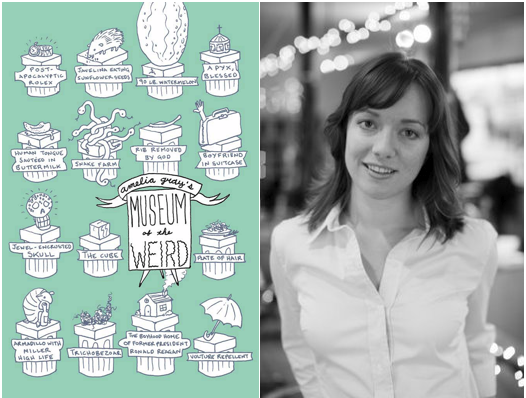This other thing the kids are doing
A review of 'Museum of the Weird'

“A student recommended Mary Miller’s Big World to me the other day; we were at a bar and she brandished it like a pack of the best cigarettes anyone has ever smoked.”
So begins a post (“This new thing the kids are doing”) by J. Robert Lennon on the now-defunct blog Ward Six (curated by Lennon and his wife, Rhian Ellis, for just under four and a half years).
The post isn’t so much about Mary Miller as it is about, as the title suggests, “this thing.”
“It’s partially a McSweeney’s thing,” Lennon writes. “And it’s also kind of neo-Carverian. It’s minimalist, sort of, and sometimes it’s selfconsciously [sic] odd.”
He says Amelia Gray does it too.
Gray’s new collection, The Museum of the Weird, is, indeed, representative of a certain kind of contemporary fiction. It’s a fiction that maybe couldn’t have stood a chance of flourishing before Youtube and Twitter. Before LOLcats. Before the Internet really took off. Yes, one story here, “Trip Advisory: The Boyhood Home of Former President Ronald Reagan,” appeared in McSweeney’s Internet Tendency back in 2006, but there’s something else going on here, too, something more.
In one story, “The Darkness,” an Armadillo named Betsy and a Penguin named Ray sit in a bar and drink and talk:
“I fought the darkness,” says Ray.
“Neat,” says Betsy.
It’s not really an allegory, and its ending doesn’t suddenly recast what came before it, throwing it all into a new light. Really, it’s more like an absurdist joke — the comedic work of Tim Heidecker and Eric Wareheim, or of Zach Galifianakis, comes to mind before anything else.
Another story, “Fish,” begins like this: “Dale was married to a paring knife and Howard was married to a bag of frozen tilapia.” She leads with the punch line and then builds a world around it. It’s sublime for its not meaning anything.
Yet Lennon’s critique of this kind of work is understandable: he says it can seem
“precious, or random…like a night spent smoking pot in your sister’s apartment with her grad school friends. You know they’re smart, and you know you’re as smart as they are, but you don’t understand a thing they’re saying. It’s not for you: it’s an insider code.”
The trouble with this kind of reading is that it overlooks the humor, or perhaps simply doesn’t get the joke; misinterprets it as something more earnest — because that’s what Gray’s doing when she writes a story like “The Darkness,” or “Fish”: she’s telling jokes, she’s playing tricks on us.
But there’s this other thing the kids are doing that Lennon doesn’t talk about, and it’s something that Gray does in this collection, too. Her story “The Movement,” begins with this fragment: “The end of an,” and then has three paragraphs about Joseph Stalin’s funeral. The pattern continues: “What they provide and how they function (present day)” followed by a relatively coherent paragraph. Gradually, a story emerges, but it’s buried beneath a choppy form; another story, “Thoughts While Strolling,” does this too. It’s something that calls to mind the works of Donald Barthelme or Lydia Davis. Indeed, the influence of both writers is all over this collection. In “The Cube,” for instance, a mysterious cube appears in the middle of a town and, much like Barthelme’s famous balloon, serves as the vessel through which contemplation can occur.
But even at their most humorous, Barthelme’s stories gesture toward something bigger — the non sequiturs aren’t just meant to be funny. If Barthelme is an influence here, then his influence is a mixed blessing, for his legacy, really, is most visible on some of the weakest links in this collection — stories in which Gray jettisons tradition altogether and revels in the fragmentary, in the inscrutable. Whereas humor in Barthelme is a means to an end, Gray’s humor, at its best, is the end. It can seem random, yes, like a night smoking pot, but that’s because it is. When it works, it is.
The standouts in this collection are those that behave just as you’d expect them to, yet leave you in a place that you weren’t expecting to be left. They almost operate like practical jokes — luring you in with clean, unadorned sentences and then plodding along from one paragraph to the next. If you’re not paying much attention you can lose yourself in the structure and just kind of float to the end, only later realizing that you’ve been had — tugged along through a story without any real conflict or resolution to speak of. There’s something about Gray’s humor that simply is, and therein lies the beauty of this new thing the kids are doing.